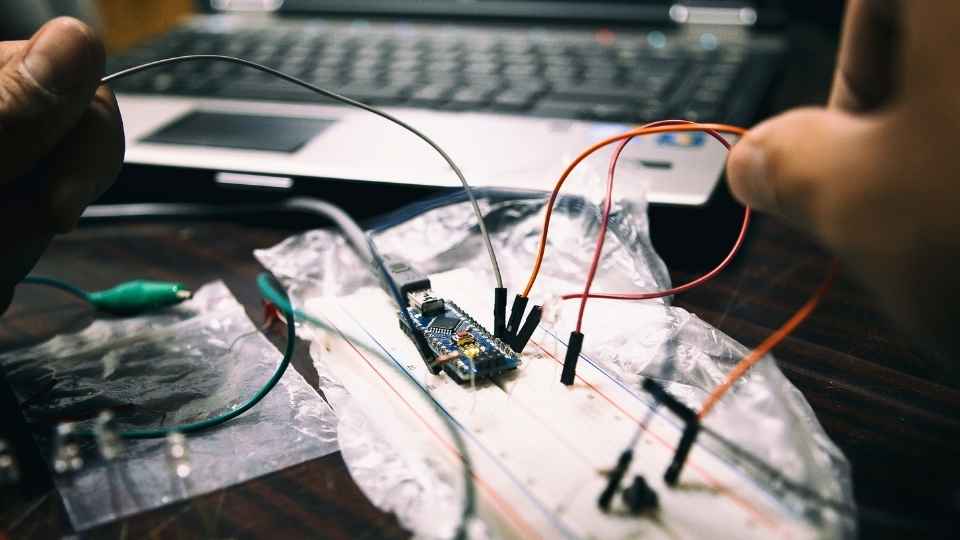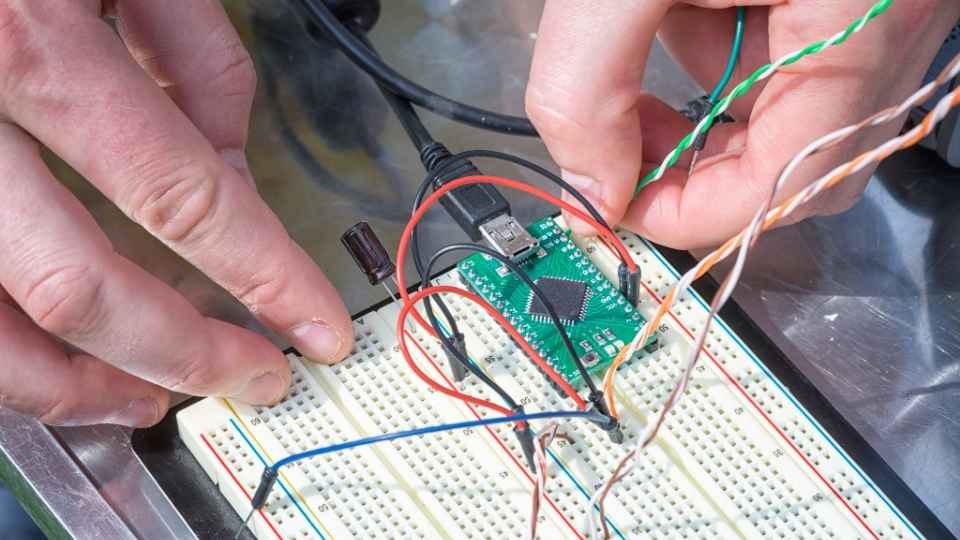
In the ever-evolving landscape of wireless communication, one question looms large: can satellite systems revolutionize the way we connect?
Enter the RF engineer - a technical expert armed with the knowledge and skills to navigate this uncharted territory. With a laser-like focus on precision, analysis, and innovation, these professionals are at the forefront of exploring how satellite systems can transform wireless communication as we know it.
In this article, we delve deep into the possibilities and challenges that lie ahead, shedding light on whether satellites truly hold the key to unlocking unprecedented freedom in connectivity.
Key Takeaways
- Evolution of wireless communication technology has transitioned from radio transmissions to cellular networks, Wi-Fi, Bluetooth, and now 5G.
- RF engineers play a crucial role in satellite systems by comprehending and optimizing signal transmission, designing advanced modulation schemes, optimizing signal propagation, and assessing system capacity.
- Satellite systems in wireless communication offer enhanced signal coverage in remote and underserved areas, seamless connectivity while moving across regions or countries, scalability to handle increasing demand, and vital role in emergency communication.
- Implementing satellite systems for wireless communication faces challenges such as signal strength limitations, overcoming those limitations with techniques and technologies, cost and infrastructure requirements, regulatory hurdles, and constant innovation pushing the boundaries of wireless communication freedom.
The Evolution of Wireless Communication Technology
The evolution of wireless communication technology has resulted in significant advancements and the potential for satellite systems to revolutionize this field. Over the years, wireless communication has evolved from simple radio transmissions to complex cellular networks and now encompasses technologies such as Wi-Fi, Bluetooth, and 5G. These advancements have enabled people to stay connected anytime and anywhere, providing freedom from physical limitations.
The development of satellite systems further expands the possibilities of wireless communication. Satellites offer global coverage, allowing seamless connectivity even in remote areas where terrestrial infrastructure is lacking. They can transmit signals over long distances without degradation, ensuring reliable communication across borders. With satellite systems, users can enjoy high-speed internet access, voice calls, messaging services, and data transfer capabilities in even the most challenging environments.
Moreover, satellite systems have a broad range of applications beyond personal communication. They support critical sectors like disaster management, remote sensing for environmental monitoring or agriculture purposes, navigation systems for transportation industry etc., thereby enhancing safety and efficiency on a large scale.
Understanding the Role of RF Engineers in Satellite Systems
Within the field of radio frequency engineering, professionals play a crucial role in comprehending and optimizing the function of devices utilized for transmitting and receiving signals from space-based platforms. These experts possess the technical knowledge and skills necessary to design, analyze, and troubleshoot complex systems that rely on satellite communication. They are responsible for ensuring efficient signal transmission, minimizing interference, and maximizing overall system performance. RF engineers work closely with other specialists such as antenna designers, network architects, and software developers to develop innovative solutions that meet the demands of modern wireless communication.

- Conducting detailed electromagnetic analysis.
- Designing and implementing advanced modulation schemes.
- Optimizing signal propagation through atmospheric conditions.
- Assessing system capacity for handling high volumes of data.
With their expertise in satellite systems and wireless communication technologies, RF engineers are instrumental in revolutionizing the way we connect with each other across vast distances.
Exploring the Benefits of Satellite Systems in Wireless Communication
Satellite systems have revolutionized wireless communication by providing enhanced signal coverage and global connectivity potential. These systems utilize a network of satellites in space to transmit signals, allowing for seamless communication across vast distances.
With the ability to reach areas where terrestrial infrastructure is limited or non-existent, satellite systems offer tremendous benefits in expanding wireless communication capabilities on a global scale.
Enhanced Signal Coverage
Enhanced signal coverage is a crucial aspect of wireless communication that can be significantly improved through the use of satellite systems. Satellite systems offer several advantages in terms of signal coverage, including:
Wide geographic reach: Satellites can provide coverage to remote and underserved areas where traditional terrestrial infrastructure may not be feasible or cost-effective.
Seamless connectivity: With satellites, users can experience uninterrupted connectivity even while moving across different regions or countries.
Scalability: Satellite systems can easily accommodate increasing demand for wireless communication by adding more satellites to the network.

Emergency communication: In times of natural disasters or emergencies, satellite systems play a vital role in providing reliable communication services when other networks may be compromised.
With these advantages, satellite systems have the potential to revolutionize wireless communication by ensuring global connectivity and bridging the digital divide.
Global Connectivity Potential
The potential for global connectivity in wireless communication is vast, with satellite systems offering wide geographic reach and seamless connectivity. These systems can revolutionize the way we communicate by providing coverage to remote areas and enabling communication during natural disasters or emergencies.
Satellite systems operate by transmitting signals from ground stations to satellites orbiting the Earth, which then relay these signals back down to receiving devices on the ground. This allows for a global network of communication that transcends physical boundaries.
Moreover, satellite systems can provide high-speed internet access in areas where terrestrial infrastructure is lacking or non-existent, thereby bridging the digital divide and empowering individuals with freedom of information and communication.
The future possibilities of satellite-based wireless communication are immense, promising a world where everyone can stay connected regardless of their location or circumstances.
Overcoming Challenges in Implementing Satellite Systems for Wireless Communication
The implementation of satellite systems for wireless communication presents several challenges that need to be overcome.

These challenges include signal strength limitations, which can affect the quality and reliability of communication, as well as cost and infrastructure requirements, which may pose financial and logistical obstacles.
Additionally, regulatory hurdles and restrictions can impact the deployment and operation of satellite systems in certain regions or countries.
Signal Strength Limitations
Signal strength limitations in wireless communication can pose significant challenges for the deployment and performance of satellite systems. These limitations can result in reduced coverage, slower data rates, and increased latency.
To overcome these challenges, engineers have developed various techniques and technologies:
Power control: By adjusting the transmit power based on the received signal strength, power control algorithms help optimize the link quality.
Antenna design: Advanced antenna systems such as phased arrays and smart antennas can improve signal reception and transmission efficiency.
Frequency planning: Careful allocation of frequencies helps minimize interference and maximize spectral efficiency.

Signal processing algorithms: Sophisticated algorithms like beamforming, adaptive modulation, and coding schemes are employed to enhance signal quality.
These techniques collectively contribute to improving signal strength in satellite systems, enabling better coverage and higher data rates. As technology evolves, innovative approaches continue to push the boundaries of wireless communication freedom.
Cost and Infrastructure Requirements
Cost and infrastructure requirements play a crucial role in determining the feasibility of implementing satellite systems for revolutionizing wireless communication.
The deployment of satellite networks necessitates substantial financial investments due to the need for constructing and launching satellites into space, establishing ground stations, and maintaining the entire network.
Additionally, ensuring a robust infrastructure that can handle high-speed data transfer and support seamless connectivity across vast geographical areas is essential. This involves setting up a network of interconnected ground stations, which must be strategically located to achieve optimal coverage.
Furthermore, the installation of user terminals at end-user locations adds to the overall cost and complexity.
It is imperative to carefully assess these cost implications and devise effective strategies to make satellite systems economically viable without compromising on quality or accessibility.

As we delve into regulatory hurdles and restrictions, it becomes evident that overcoming these challenges is crucial for realizing the potential of satellite systems in transforming wireless communication.
Regulatory Hurdles and Restrictions
Navigating through the complex landscape of regulatory hurdles and restrictions is essential in order to fully harness the potential of satellite technology for enhancing connectivity and expanding wireless communication networks. These regulations play a crucial role in ensuring fair competition, protecting national security, and managing scarce resources. However, they can also limit innovation and hinder the growth of satellite systems.
Some key regulatory challenges that need to be addressed include:
Spectrum allocation: Efficiently allocating spectrum for satellite communications is critical to avoid interference with other services.
Licensing requirements: Obtaining licenses for satellite operations can be a lengthy and costly process, slowing down deployment.
International coordination: Coordinating with other countries on frequency usage and orbital slots is necessary to ensure global compatibility.
Privacy and security concerns: Balancing the need for secure communication with individual privacy rights requires careful consideration.

Overcoming these challenges will enable the full potential of satellite systems to revolutionize wireless communication while maintaining freedom and fairness in our connected world.
Case Studies: Successful Integration of Satellite Systems in Wireless Networks
With the successful integration of satellite systems in wireless networks, notable case studies have demonstrated the potential for a revolutionized approach to wireless communication. These case studies highlight the benefits of incorporating satellites into existing wireless infrastructure, paving the way for enhanced coverage and improved connectivity.
For instance, one study conducted by a leading telecommunications company showcased how leveraging satellite technology resulted in expanded network reach to remote areas that were previously underserved.
Another case study focused on disaster management scenarios where satellite systems proved critical in establishing reliable communication links during emergencies.
By harnessing the power of satellites, wireless networks can overcome geographical limitations and provide uninterrupted connectivity, even in challenging environments.
The success of these case studies underscores the immense potential for satellite systems to transform wireless communication and deliver freedom of connectivity to all users.
The Future of Wireless Communication: Satellite Systems as Game Changers
As wireless networks continue to evolve, the incorporation of satellite technology holds immense promise for revolutionizing connectivity and expanding coverage capabilities. This combination has the potential to overcome traditional limitations and provide seamless connectivity even in remote areas. The future of wireless communication looks bright with the integration of satellite systems, offering new possibilities and opportunities.

Advantages of Satellite Systems in Wireless Communication:
- Global Coverage: Satellites can provide coverage across large geographical areas, including remote regions where terrestrial infrastructure is limited or nonexistent.
- High Bandwidth: Satellites offer high bandwidth capacity, enabling faster data transmission rates and supporting emerging technologies like IoT and 5G.
- Reliability: Satellite systems are less prone to physical disruptions such as natural disasters or man-made incidents, ensuring uninterrupted communication.
- Flexibility: Satellites can be deployed quickly to address temporary needs or emergencies, making them an ideal solution for rapid deployment scenarios.
With these advantages, satellite systems have the potential to revolutionize wireless communication by bridging the digital divide, connecting underserved populations, and enhancing overall global connectivity.
Frequently Asked Questions
How Does the Evolution of Wireless Communication Technology Impact the Role of RF Engineers in Satellite Systems?
The evolution of wireless communication technology has significantly impacted the role of RF engineers in satellite systems. It has necessitated their ability to adapt and innovate in order to meet the increasing demands and complexities of these systems.
What Are Some Specific Challenges That RF Engineers Face When Implementing Satellite Systems for Wireless Communication?
Challenges faced by RF engineers in implementing satellite systems for wireless communication include issues related to signal interference, synchronization, power consumption, frequency allocation, and the need for complex antenna designs. These challenges require technical expertise and strategic planning.
Can You Provide Examples of Successful Integration of Satellite Systems in Wireless Networks?
Successful integration of satellite systems in wireless networks can be seen in the deployment of satellite backhaul solutions, which enable seamless connectivity in remote areas and provide reliable communication for disaster recovery, military operations, and maritime applications.
How Do Satellite Systems Revolutionize Wireless Communication and What Specific Benefits Do They Bring?
Satellite systems revolutionize wireless communication by providing global coverage, overcoming geographical limitations, and enabling connectivity in remote areas. They offer increased bandwidth, improved reliability, and reduced latency, enhancing the overall performance of wireless networks.
What Does the Future Hold for Wireless Communication and How Will Satellite Systems Play a Role in Shaping It?
The future of wireless communication will be shaped by various factors, including the role of satellite systems. These systems offer the potential for global connectivity and improved coverage, making them an important part of revolutionizing wireless communication.

 Basic Electronics ConceptsEssential ToolsCircuit Design BasicsMicrocontrollersDIY Electronics ProjectsRoboticsPrivacy PolicyTerms And Conditions
Basic Electronics ConceptsEssential ToolsCircuit Design BasicsMicrocontrollersDIY Electronics ProjectsRoboticsPrivacy PolicyTerms And Conditions
